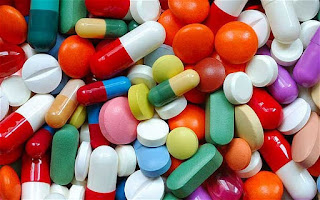Haloperidol decanoate
Trade name: Apo-Haloperidol, Haldol, Haldol
Decanoate, Haldol, Novo-Peridol, Peridol, PMS-Haloperidol.
Drug classes
• Dopaminergic
blocking drug
• Antipsychotic drug
• Butyrophenone (not a phenothiazine)
Pregnancy: (Category C)
Action:
Mechanism not fully
understood: antipsychotic drugs block postsynaptic dopamine receptors in the
brain, depress the RAS, including those parts of the brain involved with
wakefulness and emesis; chemically resembles the phenothiazines. Indications
• Management of manifestations of psychotic disorders
•
Control of tics and
vocalizations in Gilles de la Tourette's syndrome in adults and children
•
Short-term treatment of
hyperactive children who also show impulsivity, difficulty sustaining
attention, aggressivity, mood lability, or poor frustration tolerance
• Prolonged parenteral therapy of chronic schizophrenia
(haloperidol decanoate)
• Unlabeled uses: control of
nausea and vomiting, control of acute psychiatric situations (IV use)
Contraindications/cautions
• Contraindications: coma or
severe CNS depression, bone marrow depression, blood dyscrasia, circulatory
collapse, subcortical brain damage, Parkinson's disease, liver damage, cerebral
arteriosclerosis, coronary disease, severe hypotension or hypertension.
• Use cautiously with respiratory
disorders ("silent pneumonia"); glaucoma, prostatic hypertrophy
(anticholinergic effects may exacerbate glaucoma and urinary retention);
epilepsy or history of epilepsy (drug lowers seizure threshold); breast cancer
(elevations in prolactin may stimulate a prolactin-dependent tumor);
thyrotoxicosis; peptic ulcer, decreased renal function; myelography within
previous 24 h or scheduled within 48 h; exposure to heat or phosphorous
insecticides; lactation; children younger than 12 y, especially those with
chickenpox, CNS infections (children are especially susceptible to dystonias
that may confound the diagnosis of Reye's syndrome); allergy to aspirin if
giving the 1-, 2-, 5-, and 10-mg tablets (these tablets contain tartrazine).
Dose:
§ by mouth,, short-term
adjunctive management of psychomotor agitation, excitement, and violent or
dangerously impulsive behavior, initially 1.5–3
mg 2–3 times daily or 3–5 mg 2–3 times daily in severely
affected or resistant patients; adjusted according to response to lowest
effective maintenance dose (as low as 5– 10 mg daily);
Elderly (or debilitated) initially half adult dose; Child initially 25–
50 micrograms/kg daily (in 2 divided doses) to max. 10 mg
§ Agitation and restlessness in the elderly, initially 0.5–1.5 mg
once or twice daily
§ Short-term adjunctive management of severe anxiety, 500
micrograms twice daily; CHILD not recommended
§ Intractable hiccup, 1.5 mg 3 times daily adjusted according to
response; CHILD not recommended
§ Nausea and vomiting, 1 mg daily
§ By intramuscular or by intravenous
injection, initially 2–10 mg, then every 4–8 hours according to response
to total max. 18 mg daily; severely disturbed patients may require initial dose
of up to 18 mg; elderly (or debilitated) initially half adult dose; CHILD not recommended Nausea and vomiting, 0.5–2 mg
Adverse effects
Not all effects have been reported with
haloperidol; however, because haloperidol has certain pharmacologic
similarities to the phenothiazine class of antipsychotic drugs, all adverse
effects associated with phenothiazine therapy should be kept in mind when
haloperidol is used.
• CNS: Drowsiness, insomnia,
vertigo, headache, weakness, tremor, ataxia, slurring, cerebral edema,
seizures, exacerbation of psychotic symptoms, extrapyramidal
syndromes-pseudoparkinsonism; dystonias; akathisia, tardive dyskinesias,
potentially irreversible (no known treatment), neuroleptic
malignant syndrome--extrapyramidal symptoms, hyperthermia, autonomic
disturbances
• CV: Hypotension, orthostatic hypotension, hypertension,
tachycardia, bradycardia, cardiac arrest, CHF, cardiomegaly, refractory arrhythmias (some fatal), pulmonary edema
•
Respiratory: Bronchospasm,
laryngospasm, Dyspnea; suppression of cough reflex and
potential for aspiration
•
Hematologic:
Eosinophilia, leukopenia, leukocytosis, anemia; aplastic anemia; hemolytic
anemia; thrombocytopenic or nonthrombocytopenic purpura; Pancytopnea
•
Hypersensitivity: Jaundice, urticaria, angioneurotic
edema, laryngeal edema, photosensitivity, eczema, asthma, anaphylactoid reactions, exfoliative dermatitis
•
Endocrine:
Lactation, breast engorgement in females, galactorrhea; SIADH; amenorrhea,
menstrual irregularities; gynecomastia in males; changes in libido;
hyperglycemia or hypoglycemia; glycosuria; hyponatremia; pituitary tumor with
hyperprolactinemia; inhibition of ovulation, infertility, pseudopregnancy
• Autonomic: Dry mouth,
salivation, nasal congestion, nausea, vomiting, anorexia, fever, pallor,
flushed faces, sweating, constipation, paralytic ileus, urinary retention,
incontinence, Polyuria, enuresis, priapism, ejaculation inhibition
Nursing
Considerations
• Do not give children IM injections.
• Do not use haloperidol decanoate for IV injections.
• Gradually withdraw drug when patient has been on maintenance
therapy to avoid withdrawal-emergent dyskinesias.
• Discontinue drug if serum creatinine, BUN become abnormal or if
WBC count is depressed.
• Monitor elderly patients for dehydration; institute remedial
measures promptly; sedation and decreased thirst related to CNS effects can
lead to severe dehydration.
•
Consult physician regarding
appropriate warning of patient or patient's guardian about tardive dyskinesias.
• Consult physician about dosage reduction, use of anticholinergic
antiparkinsonism drugs (controversial) if extrapyramidal effects occur.




